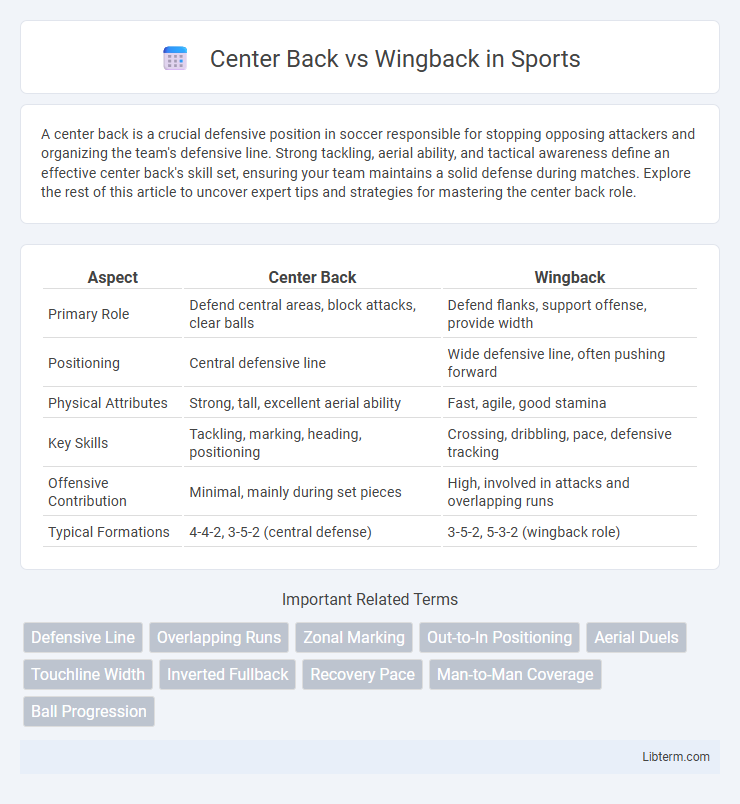A center back is a crucial defensive position in soccer responsible for stopping opposing attackers and organizing the team's defensive line. Strong tackling, aerial ability, and tactical awareness define an effective center back's skill set, ensuring your team maintains a solid defense during matches. Explore the rest of this article to uncover expert tips and strategies for mastering the center back role.
Table of Comparison
| Aspect | Center Back | Wingback |
|---|---|---|
| Primary Role | Defend central areas, block attacks, clear balls | Defend flanks, support offense, provide width |
| Positioning | Central defensive line | Wide defensive line, often pushing forward |
| Physical Attributes | Strong, tall, excellent aerial ability | Fast, agile, good stamina |
| Key Skills | Tackling, marking, heading, positioning | Crossing, dribbling, pace, defensive tracking |
| Offensive Contribution | Minimal, mainly during set pieces | High, involved in attacks and overlapping runs |
| Typical Formations | 4-4-2, 3-5-2 (central defense) | 3-5-2, 5-3-2 (wingback role) |
Introduction to Center Back and Wingback Roles
Center backs serve as the primary defenders positioned centrally in the backline, tasked with marking strikers, intercepting passes, and organizing the defense to prevent goal-scoring opportunities. Wingbacks operate along the flanks, combining defensive duties with offensive support by providing width, delivering crosses, and tracking back to assist center backs when needed. These roles require distinctive skill sets, with center backs focusing on strength and positioning, while wingbacks emphasize stamina and crossing ability.
Key Responsibilities of a Center Back
Center Backs primarily focus on defensive organization, marking strikers, and intercepting passes to prevent goal-scoring opportunities. They excel in aerial duels, clearances, and maintaining a strong defensive line to support the goalkeeper. Unlike Wingbacks, who balance defense and wide attacking runs, Center Backs concentrate on central defensive duties and leadership at the back.
Main Duties of a Wingback
Wingbacks combine defensive responsibilities with attacking support, frequently patrolling the flanks to deliver crosses and create scoring opportunities. Their main duties include tracking opposition wingers, maintaining width in attacks, and providing overlaps to stretch the opponent's defense. Effective wingbacks require exceptional stamina, speed, and crossing ability to balance their dual role in both defense and offense.
Positional Differences on the Field
Center backs primarily occupy the central defensive zone, focusing on marking strikers, intercepting through balls, and maintaining a compact defensive line. Wingbacks operate along the flanks, balancing defensive duties with offensive support by providing width, delivering crosses, and tracking opposing wingers. The positional difference lies in center backs' central anchoring role versus wingbacks' dynamic wide positioning that combines defense and attack.
Defensive Skills: Center Back vs Wingback
Center backs excel in aerial duels, marking, and tackling, playing a crucial role in organizing the defensive line and preventing central attacks. Wingbacks combine defensive skills with stamina and speed, often tracking wingers, blocking crosses, and supporting full-backs in wide areas. While center backs prioritize positioning and strength in central defense, wingbacks require agility and versatility to balance defense and offensive overlaps on the flanks.
Attacking Contributions Compared
Center backs prioritize defensive duties but can contribute to attacks through set-pieces and long balls, leveraging aerial ability and positioning to initiate offensive plays. Wingbacks play a more dynamic role in attack, frequently advancing along the flanks to provide crosses, create width, and support forwards, combining speed and stamina with effective dribbling. Attacking contributions of wingbacks generally surpass center backs due to their forward positioning and involvement in build-up play and scoring opportunities.
Physical and Tactical Requirements
Center backs require exceptional strength, aerial ability, and positional awareness to effectively defend against strikers and intercept crosses. Wingbacks demand high stamina, speed, and agility to balance defensive duties with overlapping runs and wide attacking support. Tactically, center backs organize the defensive line and maintain compactness, while wingbacks provide width, deliver crosses, and track back to prevent counterattacks.
Famous Players: Center Backs and Wingbacks
Famous center backs such as Virgil van Dijk, Sergio Ramos, and Franco Baresi are renowned for their positioning, aerial ability, and leadership at the heart of defense, anchoring their teams with tactical intelligence. Iconic wingbacks like Dani Alves, Marcelo, and Philipp Lahm revolutionized the role by combining defensive duties with dynamic attacking support down the flanks, contributing assists and maintaining high stamina. These players exemplify the contrasting demands and specialized skills that distinguish center backs from wingbacks in modern football tactics.
Team Formations and Tactical Setups
Center backs serve as the defensive backbone in formations like 4-4-2 or 3-5-2, maintaining positional discipline and focusing on aerial duels and central clearances. Wingbacks operate in formations such as 3-4-3 or 5-3-2, combining defensive responsibilities with offensive width by providing crosses and supporting midfield transitions. Tactical setups utilizing wingbacks emphasize dynamic flanks and overloads, while center back-centric formations prioritize compactness and central defensive solidity.
Choosing Between a Center Back and Wingback
Choosing between a center back and a wingback depends on your team's tactical setup and defensive strategy. Center backs primarily focus on central defense, marking strikers, and intercepting attacks, while wingbacks combine defensive duties with attacking support down the flanks, offering width and crossing options. Opt for a center back to strengthen central defense and prioritize physicality and positioning, or select a wingback to enhance offensive transitions and provide pace and stamina on the sidelines.
Center Back Infographic

 libterm.com
libterm.com